North Vietnam, Postage Due Hand Stamps, 1954-1955, Michel Nr. D1-13; Prior to the issuance of the first postage due stamp in North Vietnam, released in July 1955, the country had simply used hand stamps, that were mostly struck in black ink (more rarely in red, blue or brown) directly on the envelope to indicate to the delivery person or post master that prior to handing over the letter he/she had to collect the postage that was due. Like in Indochina before, the form and shape of the hand stamp was not nationally ordered by the central post office but it was left up to each local office to produce their own hand stamps. We see the same on envelopes from Indochina and South Vietnam which also show numerous different ones. So, it appears, that apart from the general policy to collect postage due from under-franked letters and the postage due stamps printed for that very purpose at certain times, no general valid norm, on how to execute the dues collection process, existed in Indochina, South Vietnam or North Vietnam at any time. This is evidenced by the myriad of different hand-written or stamped “T” or “T.T” marks that appear from the 1880’s to this date on postally used letters across Indochina/Vietnam and that all show some signs of variation.
Below is a letter mailed from the Chief Veterinarian in Saigon in 1912 to an address in Paris, France. The letter was not prepaid so the envelope was struck with a black “T” hand stamp in a triangle in Indochina. The postage due of 20 Centimes was then collected in France as documented by the postage due stamp on front that was cancelled by a black triangle in Paris. So, even in France postal clerks were prone to striking the postage due hand stamps on the stamp itself.
Here is a North Vietnamese sample of a more recent letter from 1975. After 1958 North Vietnam abandoned the issuance of postage due stamps and reverted back to the “T” or “T.T.” hand stamps such as this rectangular one that allowed the clerk to write in the penalty due.
Many different postage due hand stamps existed in North Vietnam in the early 1950’s. Small post offices did not even bother to have a hand stamp but simply wrote “T” or “T.T.” on the envelope. Some hand stamps were in the shape of a diamond or rhombus shape. Others were in rectangular boxes that had a space in which the postage due could be written in as shown above. What they all had in common though were the letters “T” or “T.T.” which stood for “Tem Thieu” or “Postage Due”. Sometimes a capricious postal clerk may have struck this hand stamp directly on a postage stamp that was affixed to the envelope for paying the fine so the stamp could not be re-used later. Some larger post offices may have done so more systematically prior to an under-franked letter arriving, so they probably prepared entire sheets of regular postage stamps with their own “T.T.” hand stamps that were then to be used when the opportunity arose. But this was simply a local preference and there is no evidence it was mandated by the central postal administration. Since there was no norm provided by higher authorities, post offices simply established their own proprietary processes. Some post offices clearly stayed with the hand-written „TT“ remarks on letters while others, tired of hand-writing, established better , more efficient processes by having hand-stamps made to express that postage was due. One would surmise that smaller offices handling little volume used hand-written remarks while larger offices had themselves hand-stamps made. In well over 99% of the hundreds of cases that the editor has seen, the „T“ or „TT“ remark is written or stamped on the envelope itself. In only a tiny portion of these cases, the postal worker struck the „T“ /„TT“ hand-stamp on the stamp itself. So, it is not surprising that only two North Vietnamese covers have ever been recorded by Klewitz that bear stamps on which a “TT” hand stamp was applied. This may have represented just a capricious preference of a particular postal clerk, or, as will be shown later, was done because date cancelers were not on hand or the strike on a stamp was performed by someone who wanted to entice collectors. Producing philatelic curiosities has a long tradition and dates back to the 1880’s.
These two letters from South Vietnam demonstrate what the editor means. Here is a letter, that most likely stems from the early 1950’s and is franked with a combination of Indochinese and a South Vietnamese stamp. Here the postal worker has struck the “T” triangle hand-stamp on the stamps, as well as the envelope. Most likely the letter arrived without a cancel in the Saigon post office, where someone note the lack of cancellation. Not knowing the actual weight of the item, it is impossible to say if the letter was in fact under-paid, but, we do know that the local letter rate from October 1951 through 1955 was $1.50, the very amount that is affixed to the envelope. May be the letter was posted after March 31st, 1952, when Indochinese stamps had been declared invalid? At any rate, the person cancelled the affixed stamps with the “T” triangle and struck another and stamp on the envelope which, normally, would indicate that additional postage was due. Like is usual, there is no indication on the envelope if postage due was ever collected. 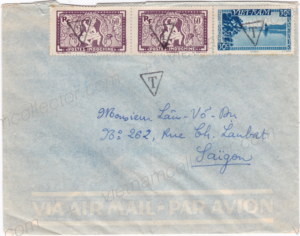
Here is another letter from South Vietnam from 1965 that shows a similar picture. When the letter was mailed in Tanan the date cancel was mistakenly just applied on the envelope but not the stamps. So again, the postal worker in Saigon, cancelled the stamps with a triangular „T“ stamp upon arrival. Like with the other example it is not clear if this letter, that most likely contained a printed invitation, is improperly franked or not at the printed matter rate.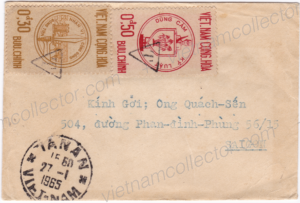
It seems likely the clerks in the postal sorting department of the Saigon post office had access to „T“ hand-stamps but not to regular date cancelers and so they just used the tool they had on hand to mark the stamps as used as well as to indicate any postage due.
At any rate, these two examples demonstrate, how just a few capricious postal workers, can produce covers that suddenly become very interesting to collectors. By no means is the editor suggesting that South Vietnam ever produced stamps that were officially over-printed with triangular „T“ hand-stamps and that these letters hence represent extremely rare South Vietnamese postal history. No, they are most likely one-off items that were just created by chance or malfeasance. By the same token, though, we should question, that the existence of just two early North Vietnamese letters that essentially show the same characteristics as the South Vietnamese letters presented here, are based on postal directives used countrywide. There is simply not enough evidence for that. Every serious Vietnam collector knows how exceedingly rare genuine postal history franked with the local stamps in the LKV is, yet there are a lot more examples of commercial usage of these stamps as there are of the „TT“ hand stamps on cover. Had the „TT“ overprinted stamps been produced by local directive, say in just one province, one would still expect to find many more examples of them on cover. Certainly a lot more, had they been produced for all of North Vietnam and that is simply not the case.
Well renownd philatelist Theo Klewitz, was a well respected philatelist in many areas including Vietnam, but as man he also was not infallible. I have no doubt that Klewitz obtained his North Vietnamese letters that feature stamps with a “T.T.” hand stamp in the mid 1950’s. As a keen philatelist, he must have been surprised when he got these letters from his Vietnamese contacts and probably was wondering, what he was on to. It would be normal for any collector to ask, if his contacts could produce more examples of these newly found „overprints“. Certainly other collector upon learning about the Klewitz discovery were keen to obtain samples of their own. Demand was created and industrious and profit oriented minds in Vietnam filled it. It is a well known fact that of most over-printed North Vietnamese stamps there are more fakes than genuine items. „T“/„TT“ hand stamps in the sorting departments were not subject to a great deal of security. After all they created no rights, but only obligations when struck on an envelope. It would therefore have been very easy for a postal worker to get a hold of a „T“/„TT“ stamp and use it to produce whole sheets of overprints for collectors. And this is exactly the pattern that we have seen in the philatelic market. Starting in the mid 1950’s these overprints appeared, initially produced with the same or similar hand-stamps as the ones on the Klewitz letters. One can tell their age by the way the ink has penetrated the paper and faded over time. Later on, other producers emerged using new „TT“ hand-stamps from other post offices or self produced fantasy hand stamps, creating ever new varieties. This continues to-date sometimes in hilarious ways when forgers use neon colors, unavailable in the 1950’s to produce their over-prints. Here are some samples of “T.T.overprints of which the editor believes that they are genuine, genuine meaning they were actually employed by post offices at the time to mark envelopes for which postage was due.
Here is block of four of the 100D in brown carrying a brown-red “T.T.” overprint in a partially double lined rhombus box. The overprint color was most likely simply a function of one clerk using a black ink pad and the next clerk using a red ink pad resulting in the brown-red mixture.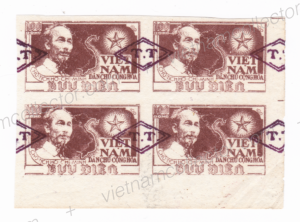
This is the same overprint also on the 100D brown in red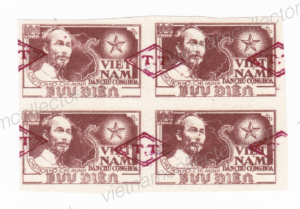
Here is a pair of the 100D value in lilaq-brown with a larger “T.T.” in a partially double limed rhombus box overprint in red.
This a block of four on the green 100D value with a black overprint of “T.T.” in a single lined rhombus box.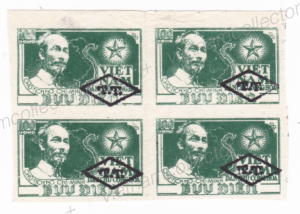
Here a single perforated 100D stamp in green with a larger, partially double-lined rhombus box with”T.T.” 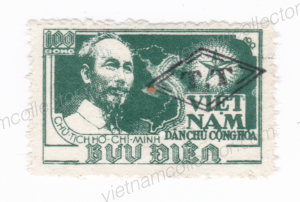
This is a partially double-lined rhombus box with a “T.T.” overprint in red on the 100D green stamp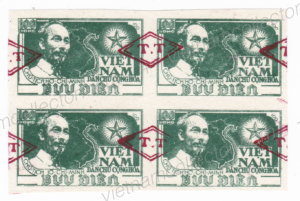
Here are two single 200D stamps in brick-red with a red “T.T.” overprint in a partial double-lined rhombus box.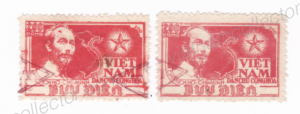
Here are two single stamps. One with a rhombus box in which the TT is spaced wide and the other with a rectangular TT box.
The only genuine cover with the overprinted Ho Chi Minh stamps the editor has ever seen comes from the Klewitz collection. It is franked with a pair of the 200D HCM stamps overprinted with a smaller red “T.T.” hand stamp in a partially double lined rhombus box used on April, 25th, 1955 in Hanoi. The cancel looks genuine. It purports to be a local letter but is most likely a philatelic creation and the address was added at a later date. The standard letter rate at the time was 100D so the penalty for dropping an un-franked standard letter into a mail box would have been just 200D (double the standard tariff) and not 400D (unless the letter would have been of the second weight level which is not indicated as the letter has no content and is still sealed). Also it is not clear what currency these stamps purport to be issued in. The un-overprinted stamps were issued in May 1st of 1951 in “Old Dong”. This currency was devalued by 10:1 on May 6th, 1951 and replaced by the “Dong Ngan Hang”. After the Viet Minh took over power from the French in October of 1954 the stamps were formally devalued by overprinting them with one tenth of their original value. This begets the question what face value in “Dong Ngan Hang” did the Vietnamese postal administration assign to these overprinted stamps? Did they still represent their value in “Old Dong”, one tenth in “Dong Ngan Hang” or was the TT overprint enough to signify that these stamps now represented 100% of face value in “Dong Ngan Hang”? Depending on answer the postage due added to this cover represented 40D or 400D in “Dong Ngan Hang”. Neither amount makes sense based on postal rates at the time.
The “T”T hand stamps also appears on other base stamps from the era. Below are two stamps of the “Production and Thrift” series 100D with a blue single line overprint. These are the overprinted stamps that were used on the two letters collected by Klewitz.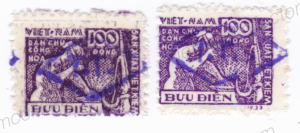
and here is the 100D value of the “Month of Friendship” series with a black overprint in a partial double line rhombus box.
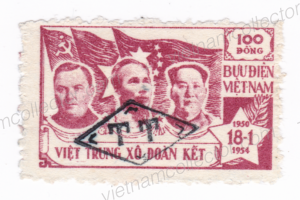
There are plenty of forged “T.T.” overprints, so beware. Forged meaning they were private home-made productions created to simply defraud collectors. They are mostly recognizable by the way the ink of the overprint has soaked into the paper. Genuine older overprints from the 1950’s are generally a bit faded (in the case of the red or brown color) or a bit “fuzzy” for the black overprints. Sometimes complete letters as this one are offered in the market place. Complete letters are by no means a guarantee that the item is genuine. Here everything is forged: the stamps, the cancel, the cachets and the “T.T.” overprints.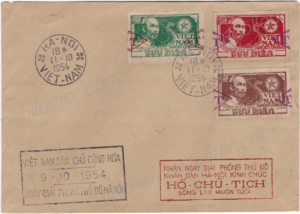
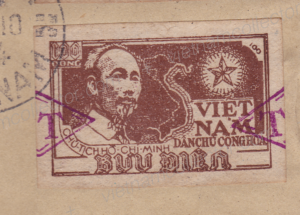
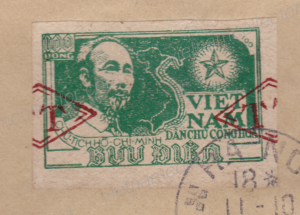
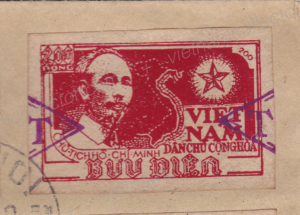
Beware of this cancel that clearly has been compromised. It was either stolen from the post office or is home-made production. Any letter that carries it has to be closely questioned.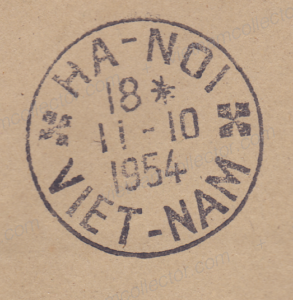
Some collectors will object: “but they are listed in most of the stamp catalogues, so they must be real”. Well, take a look at the employee roster of the Schwanberg printing house that produces the Michel catalogues (www.briefmarken.de). The number of staff available to produce and up-date these catalogues is extremely limited. This means that a staff member must deal with many countries at the same time and by definition in depth knowledge of any one subject is rather limited. (Annotation: Since writing this article the Michel catalogue has removed the number and names of staff responsible for individual countries or tasks from their website replacing it with a general contact e-mail. This is an attempt to obfuscate the embarrassingly limited staffing the catalogue maintains. Nevertheless there is a still a photograph of the entire staff, a total of 26 persons, which includes management, sales people and administrative assistants). The catalogues therefore very much depend on individual collectors who are recognized as authorities in their respective fields to assist them. Klewitz was the trusted Vietnam advisor to Michel for many years. He pretty much single handedly wrote the catalogues section about early North Vietnam and the local LKIV and LKV issues. So it is not difficult to understand how the „TT“ over-prints were accepted into the Michel catalogue. I have no information on when and how the other catalogue makers accepted the „TT“ overprints into their catalogues. In their latest 2018 edition of the South East Asia catalogue, Michel has annotated the postage due stamps (Michel P1 through P13) with the following remark: “About the circumstances that led to the creation of the over-prints MiNr. 1-13 more research is necessary. Because of the ease with which these over-prints can be falsified, philatelic material is hard to distinguish from genuine material“. So while Michel has not given up on these stamps altogether yet, a first step has been made that will allow Michel an „out” in a few more years, without losing too much face with collectors.
Many collectors have invested hundreds or more Dollars in collecting these over-prints, the editor included. So one would expect that his theory does not reverberate well with some people in the hobby. No one wants their valued investments declared as accidental, made-up items or even forgeries. Nevertheless, the editor has a mandate to seek the truth and uncover deceptive or fraudulent practices, wherever they exist. The presented theory may not be 100% accurate, for that one would have to have access to the relevant North Vietnamese postal directives that may no longer exist, but it is based on the evidence available (or better said the lack thereof) so far. The present theory, that these over-prints were ordered by provincial or national postal authorities and hence represent official issues of North Vietnam based on the evidence of just two letters appears a lot more far fetched. The author would be very interested to hear different opinions from fellow collectors ideally supported by some physical evidence.
Registration Nr.100045

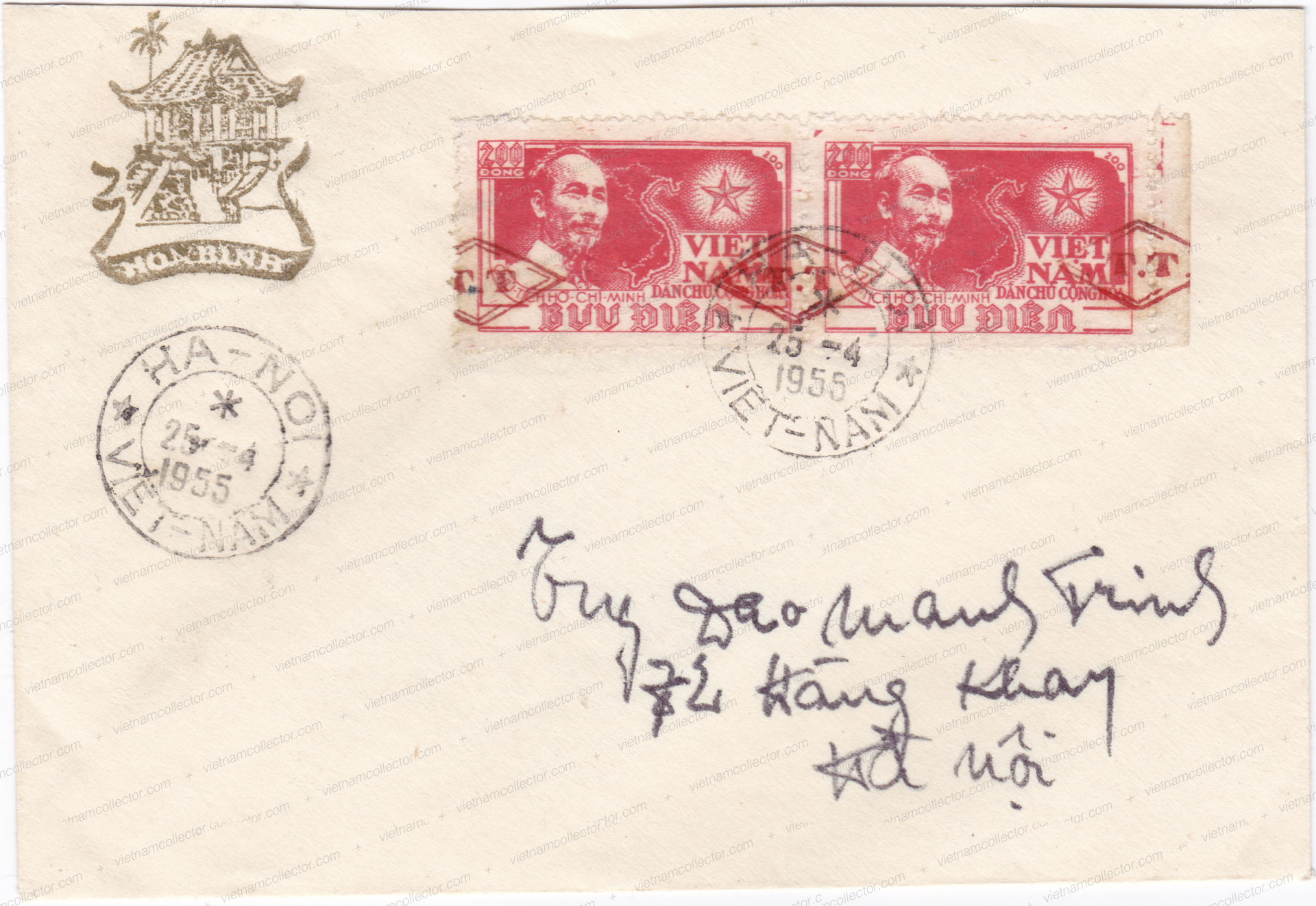
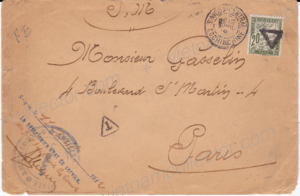
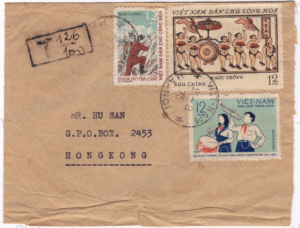
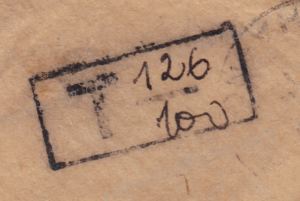
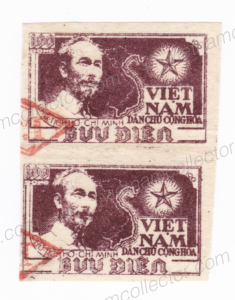
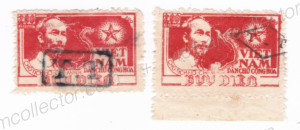
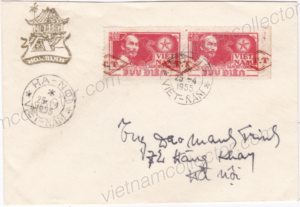
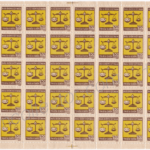
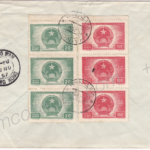
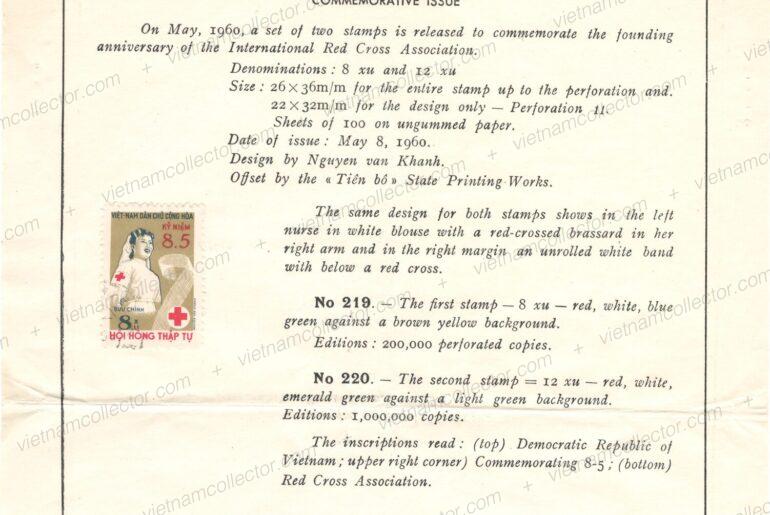
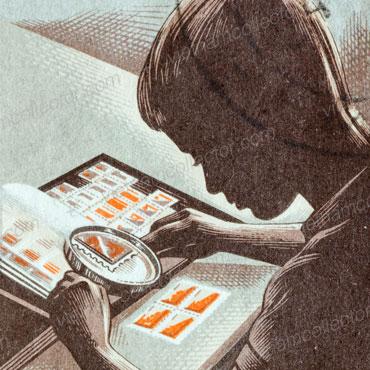
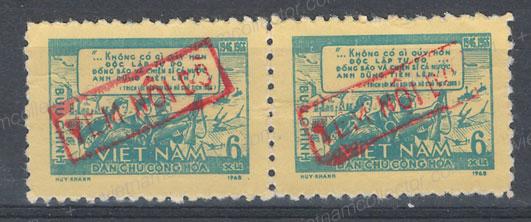
Comments are closed.